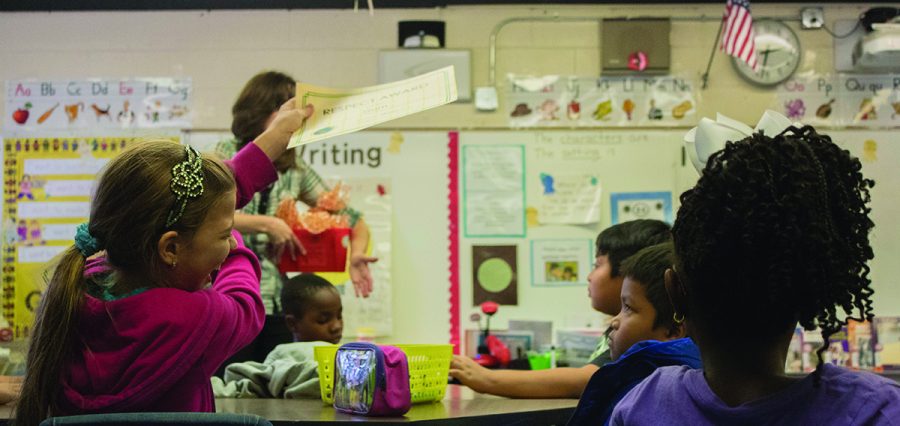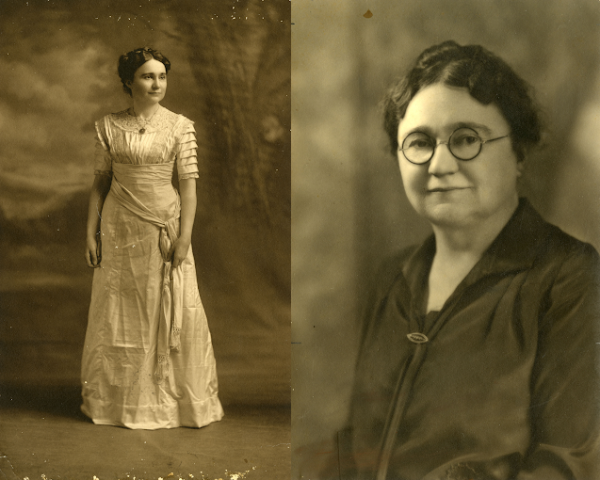Greensboro school welcomes 320 students new to the U.S.
A young girl at the Doris Henderson Newcomers School shows her classmates her certificate for being respectful in class on Monday, Nov. 6, 2017. Newcomers is a school located in Greensboro, North Carolina. //Photo by Julia Martins de Sa/The Guilfordian
It’s a routine that began at the start of the academic year in August. Abu Zaeem, the principal of Doris Henderson Newcomers School, stands at the entrance of the school everyday to greet around 300 students who arrive by bus.
“When they first start in August, you always want to create that culture of greeting them,” said Zaeem. “A lot of them coming in, they didn’t say ‘good morning’ and rightfully so, because they might not have known what ‘good morning’ was.”
As of Nov. 2, 320 students attend the Newcomers School located in Greensboro, North Carolina. They range in grade level from the third grade to the eleventh grade. These students come from 23 different countries and speak 29 different languages.
But those numbers are subject to change. Each week, the Newcomers School gains around eight to 10 new students. These students attend the school for one year to learn English and to prepare for their transition into a mainstream American school.
“Working with the (District of Columbia) Office For Civil Rights, our students come to Newcomers for a year,” said Zaeem. “We have to be very careful because any time that we take either refugee or immigrant students, we can pull them out for the sake of providing the initial support for them, to bring them up to speed with what they will be facing when they go into an American school.
“We bring them in, we do two semesters with them. At the end of that one year, we transition them into their zone school, which is wherever they’re living.”
Learning English is a challenge for the students, but the Newcomers School works with them to address the language barrier. A significant measure used to do this is curriculum that recycles throughout the year to ensure students do not miss learning any content.
“Our focus is on literacy and language acquisition,” said Curriculum Facilitator Valeria Kouba. “We basically try to organize our literacy or language units … in a way that they will recycle during the year. So at the beginning of the year, during the first semester, we cover four different units, and then when the spring comes, we will cover those four units again. So in the beginning of the fall and in beginning of the spring, you will actually have the same unit. At the end of (fall) semester, you will have a unit that’s nonfiction and is research-based. You will have the same thing in the spring, but you might be researching different things, so the topic changes.
“That gives our students an opportunity, who come in at any point during the year, to make sure that we go back to that content. If they come in November, they miss what we did in August. In this way, since we are recycling, we are able to reach all of the (students).”
The Newcomers School also follows the Sheltered Instruction Observation Model, a teaching model used specifically for English learners to address their linguistic needs in the most effective way possible.
“A lot of our teachers, they model, with hand signals and things like that, what the children are learning,” said Zaeem. “We use a lot of visuals for students to be able to understand. In a lot of classrooms, teachers put up a picture and try to introduce new vocabulary based on just that picture to get that understanding.”
According to Kouba, the school’s goal is to make the curriculum as accessible as possible, even in situations when the student’s knowledge of the English language does not align with their relative grade level.
Although the Newcomers School strives to provide the most valuable education they can, there are challenges outside of academics as well.
“As human beings, we are whole. So even if you’re in school, your academics is not everything,” said Kouba. “Your academics are going to be blocked and interrupted and there are going to be lots of other hurdles that are emotional and social. Most of our students experience trauma. Because of the situations they’re leaving in their countries before coming here, maybe the trauma was experienced in the transition between their country to the United States, or just the fact that they are in a different country, and they miss their roots. They miss their food, they miss their culture, they miss their relatives.
“All that is traumatic, so we have to be aware of that.”
Kouba said she finds it necessary to address the emotional circumstances of students due to the correlation between their affective filters and academic performance. An affective filter, a term coined by linguist Stephen Krashen, refers to the various factors that influence the processing of input, particularly when learning a second language. If students have a high affective filter, they will not retain as much in the classroom as when they have a low affective filter. For the students at the Newcomers School, the trauma they’ve experienced often causes them to have high affective filters.
“So we have to, even though we’re a school, we have to work on the emotional piece, we have to address that,” said Kouba. “Because if not, then their affective filter is going to be so high that it doesn’t matter what we do, they’re not going to be able to grasp that. So I would say the emotional, it’s a really big piece. It’s kind of a ghost because you cannot touch it or see it. In academics, you can see numbers and you can see performance and scores and all those things.
“When you go to the emotional piece, you cannot do that, … but it’s something that has to be addressed.”
Despite the academic and emotional challenges, the Newcomers School is able to make a profound impact on students. Zaeem has noticed a positive change as he continues greeting students when they arrive at school.
“And now, when (I’m) standing there and counting the buses, … they’re greeting me,” said Zaeem. “That’s the impact that we have on them. We plant that seed and we give it a little bit of water, and then they take it and they start growing into their own people.”









